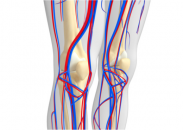Clinical practice guidelines are usually tedious and, frankly, while a lot of people make an enormous effort to write them, they are ultimately read in full by just a few. These new European Guidelines on the Management of Lower Limb Acute Ischemia represent a special team effort, since they include physicians, cardiologists, surgeons, and interventionists,…
Drug-Coated Balloons vs. Conventional Angioplasty Below the Knee
This meta-analysis is an update on the role of drug-coated balloons in the treatment of infrapopliteal arterial disease, a difficult pathology for all strategies. The primary endpoint of this meta-analysis was treated lower limb salvage at 12 months. The secondary endpoints included survival at 12 months, amputation free survival, restenosis, and target lesion repeat revascularization rate. This…
We Should Indicate More than 6 Months of DAPT in Lower Limb Disease
Courtesy of Dr. Carlos Fava. Advanced peripheral vascular disease is frequently associated with cardiovascular events and amputation. It has been proven that mono-antiplatelet therapy (MAPT) offers some benefit (with either aspirin or clopidogrel), but there are scarce data on the role of dual antiplatelet therapy (DAPT) in these patients. Researchers analyzed 404 patients who received MAPT for…
Improved Outcomes after Lower Limb Revascularization
Operator ability combined with improved and diverse devices for lower limb revascularization has clearly increased in the last decade. However, is this technical feasibility we did not use to have translating into better clinical outcomes for patients, or is it simply inflating our interventionist egos? This study aims at answering the question above by identifying…
The Importance of Tibial Artery Patency in the Rechanneling of the Femoral Artery
After rechanneling occluded superficial femoro-popliteal arteries, interventional physicians are left with the question of how to proceed with infrapopliteal disease. This work (soon to be published in Eur J Vasc Endovasc Surg) shows us the importance of achieving patency in tibial arteries so as to obtain better mid-term outcomes. The gist is that, after an…
Exercise Programs in Peripheral Artery Disease
Programmed exercises are recommended as initial management strategy for patients with peripheral artery disease (PAD). Most exercise programs include supervised treadmill walking twice or three times a week in a strategic facility (such as a gym). PAD patients often give up on these programs seeing as they might find it difficult to keep to a…
Frailty: What Happens When We Are Too Late in Critical Lower Limb Ischemia
This condition, now “trending” among patients undergoing transcatheter aortic valve replacement (TAVR), has expanded to almost all patients we treat, always with the same outcome: the prognosis is bad, so bad that it might warrant making the difficult decision of not going forward. The association between frailty and bad prognosis is easy to see and…
HIV and Peripheral Artery Disease: Acknowledging the Association
The role of human immunodeficiency virus (HIV) in the development of vascular disease (specifically peripheral artery disease) remains unclear. Is the virus per se the direct cause of this disease or is it a consequence of dyslipidemia, one of the adverse effects of antiretrovirals? This study looked into the effect of HIV infection on peripheral…
Mortality in Peripheral Vascular Disease Drops Due to Revascularization
This cohort study shows that, from 2006 to 2015, the overall survival rate increased and the risk of major amputation decreased following lower limb revascularization. These population observations indicate that outcomes after lower limb revascularization have improved during the assessed period, and so have the centralization and specialization of interventional services. The availability and diversity…
What’s New in the European Guidelines on Peripheral Arterial Disease
Since the last version of the European guidelines on the diagnosis and treatment of peripheral arterial disease in 2011, there have been many trials and registries that warrant guideline adjustments in many aspects. The first novelty is the teamwork that gave way to these guidelines, which were written in collaboration with the European Society of…
Lesion Targeting Seems to Be the Secret in Critical Ischemia
Ulcers that do not heal, thus threatening the integrity of a lower limb in patients with critical ischemia, is a main concern. Sometimes, despite successful revascularization, major amputation cannot be prevented. The anatomical description of angiosomes started in the 70s as a way of optimizing tissue grafts. Angiosomes are basically blocks of tissue that include…









